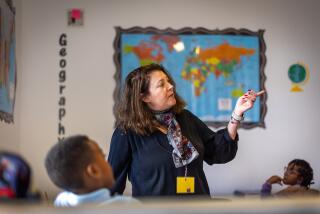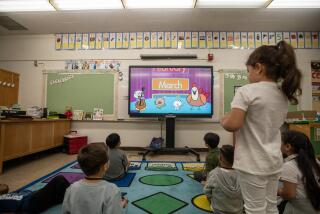Families in a Class by Themselves
- Share via
The first time Julie Smith heard her oldest son read on his own was a very special moment. Although all parents are proud of this accomplishment, Smith was especially pleased because she’s responsible. She had been his sole teacher since he was 5.
The thrill of being there for such important educational moments is one reason Smith, 35, and her husband, Craig, 34, decided to teach all of their children in their Orange home.
Today the Smith’s oldest son is 9, and they have just started teaching their second son, who is 5 1/2. Their 2-year-old son and baby-on-the-way will one day join the Smith school.
For the Smiths and a growing number of parents, the benefits of schools in the home include one-on-one, individualized instruction, increased family closeness, enhanced communication between age groups, development of independent thinking, fostering a love of learning, flexible scheduling, training in all areas of life and academic progress.
“When the parents are home schooling because they feel it’s in the best interest of their children, the one-on-one training can be ideal,” says home educational and clinical psychologist Don Smith, whose offices are in Orange. “Home schooling can establish a positive relationship between the kids and parents, enables the children to immediately get feedback and gives young people an opportunity to work at their own pace and level.”
Problems arise when parents keep children at home because of some need of their own, Smith says.
Home schooling also isn’t for everyone.
“Very few parents are suited to home school their children because it takes a major commitment on the part of the parents,” he says. “The parents must also be educated enough to be able to understand and relay concepts to their children.”
In California, home schools fall under the private school section of the education code, which means that lessons must be taught by someone capable of teaching between the hours of 8:30 a.m. and 5:30 p.m. in the English language. The home school must also be affiliated with a private school, or the parent must file an affidavit to become an independent school. California has the most lenient laws of any other state regarding home schools.
All home-school educators must keep thorough records that document education is taking place, including attendance and the teaching performed. No testing is required for home-schooled children, although many parents gauge progress with regular achievement tests.
Home schooling has become popular in recent years, says Susan Beatty, co-founder and communications director for Norwalk-based Christian Home Educators Assn. of California, which is the largest home-schooling organization in California. CHEA offers assistance and information to anyone interested in home schooling their children, regardless of religious beliefs.
“When I began home-schooling 12 years ago, there were just a handful of other people educating their children in the home,” she says. “Now a rough estimate says that there are 40,000 to 50,000 home-schoolers in California and a half-million to a million in the United States. Home schooling is also increasing in other parts of the world.”
Beatty says “studies have shown that home-schooled children test at or above the 80th percentile on national norms for standardized achievement tests.”
Although many people feel that a lack of socialization for home-schooled children is a problem, it doesn’t have to be, says psychologist Smith. “If kids are involved in other activities outside of the home with other children, they will socialize just fine,” he says.
Julie and Craig Smith began considering home schooling when Julie was pregnant with their first child. At the time, they worried about socialization, until they watched some friends’ home-schooled children.
“The children had respect for each other and others, a great deal of maturity for their age and a total lack of selfishness, which their parents attributed to home schooling,” Julie Smith says.
“Although initially we worried about socialization, we also began to see the disadvantage of too much peer interaction,” Smith says. “It’s better to learn manners and morals from Mom and Dad, rather than other children their age. Our children are learning to cooperate with children and adults.”
The Smith children participate in many social activities with other children. Every Friday afternoon during the school year they get together with a group of home-schooled children for field trips that coincide with what they are learning.
They also have community action days when they do things such as glean corn from fields for the homeless. They’ve also made a quilt and dinner for an AIDS hospice and regularly visit senior citizens at a convalescent home.
Julie Smith teaches her children during the traditional school year and keeps to a set schedule. After dressing and eating, at 9 a.m. they go to the dining room, which serves as a schoolroom.
They start with a prayer, Pledge of Allegiance and a Bible lesson until 9:30, which is taught by their father, who then leaves for work. They have social studies or science until 10:30; spelling until 10:45, and math, language arts, writing and penmanship to 12:30. Then they have lunch and physical education, including playing outside, taking a walk or riding bikes. In the afternoon they have art lessons and read for a few hours.
Although Smith’s direct teaching is usually completed by 2:30, she says she’s never really done.
“The interesting thing about teaching at home is that everything becomes a learning experience,” she says. “You tend to take advantage of all opportunities to teach your children. For instance, the kids will make dinner with me, and we’ll use our math to measure out ingredients. The youngest one can count how many forks are on the table.”
Home schooling has also enabled Smith to teach her children according to their learning styles.
“My older boy is very visual, and the younger one is more hands-on,” she says. “So I’ve matched them each with the appropriate textbooks and learning materials.”
Smith admits that teaching her children is a lot of work and takes a good deal of commitment.
“It would be a lot easier for me to send my kids to school,” she says. “It takes a lot of organization and effort on my and my husband’s part to teach our children. Things around the house tend to pile up because school takes priority. Home schooling is something you have to believe in your heart is the best thing for your children.”
Smith also spends time researching curriculum for her children and educating herself on the information. “Instead of reading magazines, I read textbooks,” she says.
Although Smith was initially worried about understanding what she needed to teach, she says she has found that she is relearning as she goes, and that it has been a broadening experience. When she reaches any areas that she doesn’t feel comfortable teaching, her husband will help if possible, or she will get together with other moms who have expertise in certain areas, and they will teach the children as a group.
The Smiths say the home-schooling arrangement has positively affected the entire family’s relationship.
“The children get along very well as friends, and I feel in tune with them on a daily basis,” Smith says. “I know how their day went, and I can deal with any problems at that moment.”
Mary and Dan Marton of Anaheim decided to home school their three children six years ago because they say it is ultimately their responsibility to educate their children, especially when they are young.
“We felt they needed constant care, regulation and more attention than a large class of children could possibly provide,” says Mary Marton, 29.
“Our goal is to raise our children to be morally responsible and motivated by love of virtue, rather than fear of correction. Because I am their mother, I felt I was the most qualified person to teach them that.”
When Marton tired of tripping over school supplies in their home, the couple built a schoolroom in their garage, which is equipped with about 500 books, a computer, room to hang art projects, a large dry-erase board and a long table where the children sit facing Marton during teaching.
This year the Martons have decided to put their two oldest daughters, who will soon be 10 and 8, into private school, and Marton will teach her youngest girl, who is almost 5, kindergarten.
“The school is a very good one, and I need a break for awhile,” Marton says. She’s says she also has a desire to put her teaching to the test and see how the girls do in a school setting. They did well on their entrance exams, she says. For the Martons it was important that their children know how to think, rather than what to think, and to regard education as a means, not an end.
“We wanted the kids to have a desire for mastering a skill or idea, rather than focus on getting a grade,” she says. “We wanted them to not only ask questions, but know where to look for answers, and to understand different points of view, even when they don’t agree with them.
“It’s takes a 100% commitment to teach your children, because it’s a full-time job,” Marton says. “Although we have set classroom hours, our whole life is really school. We make a practical application to what the girls are learning whenever possible.”
More to Read
Sign up for Essential California
The most important California stories and recommendations in your inbox every morning.
You may occasionally receive promotional content from the Los Angeles Times.










